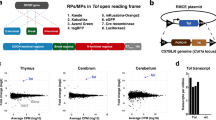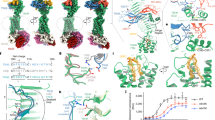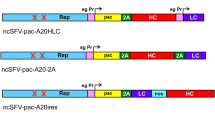Abstract
Graves’ hyperthyroidism is an autoimmune disease occurring spontaneously in humans and caused by autoantibodies that stimulate the thyrotropin receptor. In mice, inducing Graves’-like hyperthyroidism requires in vivo expression of the thyrotropin receptor using plasmid or adenovirus vectors. However, mice with different genetic backgrounds vary markedly in their susceptibility to induced hyperthyroidism. Further, in some strains major disparities exist between the induction of hyperthyroidism and detection of thyroid-stimulating antibodies. To break tolerance, virtually all Graves’ mouse models involve immunization with human thyrotropin-receptor DNA and the standard thyroid-stimulating antibody bioassay uses cells expressing the human thyrotropin receptor. We hypothesized, and now report, that disparities between hyperthyroidism and thyroid-stimulating antibody bioactivity are explained, at least in part, by differential antibody recognition of the human vs the mouse thyrotropin receptor. The genetic basis for these species differences was explored using genotyped, recombinant-inbred mouse strains. We report that loci in the immunoglobulin heavy chain variable region as well as in the major histocompatibility complex region contribute in a strain-specific manner to the development of antibodies specific for the human or the mouse thyrotropin receptor. The novel finding of a role for immunoglobulin heavy chain variable region gene involvement in thyroid-stimulating antibody epitopic specificity provides potential insight into genetic susceptibility in human Graves’ disease.
This is a preview of subscription content, access via your institution
Access options
Subscribe to this journal
Receive 6 digital issues and online access to articles
$119.00 per year
only $19.83 per issue
Buy this article
- Purchase on Springer Link
- Instant access to full article PDF
Prices may be subject to local taxes which are calculated during checkout




Similar content being viewed by others
Accession codes
References
Hollowell JG, Staehling NW, Flanders WD, Hannon WH, Gunter EW, Spencer CA et al. Serum TSH, T(4), and thyroid antibodies in the United States population (1988–1994): National Health and Nutrition Examination Survey (NHANES III). J Clin Endocrinol Metab 2002; 87: 489–499.
Vanderpump MP, Tunbridge WM, French JM, Appleton D, Bates D, Clark F et al. The incidence of thyroid disorders in the community: a twenty-year follow-up of the Whickham survey. Clin Endocrinol 1995; 43: 55–68.
Rapoport B, McLachlan SM . The thyrotropin receptor in Graves’ disease. Thyroid 2007; 17: 911–922.
Ercolini AM, Miller SD . Mechanisms of immunopathology in murine models of central nervous system demyelinating disease. J Immunol 2006; 176: 3293–3298.
Joe B . Quest for arthritis-causative genetic factors in the rat. Physiol Genomics 2006; 27: 1–11.
McLachlan SM, Nagayama Y, Rapoport B . Insight into Graves’ hyperthyroidism from animal models. Endocr Rev 2005; 26: 800–832.
Nagayama Y, Kita-Furuyama M, Ando T, Nakao K, Mizuguchi H, Hayakawa T et al. A novel murine model of Graves’ hyperthyroidism with intramuscular injection of adenovirus expressing the thyrotropin receptor. J Immunol 2002; 168: 2789–2794.
Chen CR, Pichurin P, Nagayama Y, Latrofa F, Rapoport B, McLachlan SM et al. The thyrotropin receptor autoantigen in Graves’ disease is the culprit as well as the victim. J Clin Invest 2003; 111: 1897–1904.
Kaithamana S, Fan J, Osuga Y, Liang SG, Prabhakar BS . Induction of experimental autoimmune Graves’ disease in BALB/c mice. J Immunol 1999; 163: 5157–5164.
McKenzie JM . Delayed thyroid response to serum from thyrotoxic patients. Endocrinol 1958; 62: 865–868.
Vitti P, Valente WA, Ambesi-Impiombato FS, Fenzi GF, Pinchera A, Kohn LD et al. Graves’ IgG stimulation of continuously cultured rat thyroid cells: a sensitive and potentially useful clinical assay. J Endocrinol Invest 1982; 5: 179–182.
Ludgate M, Perret J, Parmentier M, Gerard C, Libert F, Dumont JE et al. Use of the recombinant human thyrotropin receptor (TSH-R) expressed in mammalian cell lines to assay TSH-R autoantibodies. Mol Cell Endocrinol 1990; 73: R13–R18.
Muehlberg T, Gilbert JA, Rao PV, McGregor AM, Banga JP . Dynamics of thyroid-stimulating and -blocking antibodies to the thyrotropin receptor in a murine model of Graves’ disease. Endocrinology 2004; 145: 1539–1545.
McLachlan SM, Aliesky HA, Pichurin PN, Chen CR, Williams RW, Rapoport B et al. Shared and unique susceptibility genes in a mouse model of Graves’ disease determined in BXH and CXB recombinant inbred mice. Endocrinology 2008; 149: 2001–2009.
Chen CR, Aliesky H, Pichurin PN, Nagayama Y, McLachlan SM, Rapoport B et al. Susceptibility rather than resistance to hyperthyroidism is dominant in a thyrotropin receptor adenovirus-induced animal model of Graves’ disease as revealed by BALB/c-C57BL/6 hybrid mice. Endocrinology 2004; 145: 4927–4933.
Misharin A, Hewison M, Chen CR, Lagishetty V, Aliesky HA, Mizutori Y et al. Vitamin D deficiency modulates Graves’ hyperthyroidism induced in BALB/c mice by thyrotropin receptor immunization. Endocrinology 2009; 150: 1051–1060.
Aliesky HA, Pichurin PN, Chen CR, Williams RW, Rapoport B, McLachlan SM et al. Probing the genetic basis for thyrotropin receptor antibodies and hyperthyroidism in immunized CXB recombinant inbred mice. Endocrinology 2006; 147: 2789–2800.
Hernandez A, Martinez ME, Croteau W, St Germain DL . Complex organization and structure of sense and antisense transcripts expressed from the DIO3 gene imprinted locus. Genomics 2004; 83: 413–424.
Nagayama Y, McLachlan SM, Rapoport B, Niwa M . A major role for non-MHC genes, but not for micro-organisms, in a novel model of Graves’ hyperthyroidism. Thyroid 2003; 13: 233–238.
Mirza IH, Wilkin TJ . Antibody specificity in the immune response to insulin. Int Arch Allergy Appl Immunol 1989; 89: 261–263.
Minnerath JM, Wakem LP, Comfort LL, Sherman F, Jemmerson R . The BALB/c mouse B-cell response to pigeon cytochrome c initiates as a heteroclitic response specific for the self antigen mouse cytochrome c. Proc Natl Acad Sci USA 1995; 92: 12379–12383.
Shewring GA, Rees Smith B . An improved radioreceptor assay for TSH receptor antibodies. Clin Endocrinol 1982; 17: 409–417.
Kakinuma A, Morimoto I, Kuroda T, Fujihira T, Eto S, McLachlan SM et al. Comparison of recombinant human thyrotropin receptors versus porcine thyrotropin receptors in the thyrotropin binding inhibition assay for thyrotropin receptor autoantibodies. Thyroid 1999; 9: 849–855.
Seetharamaiah GS, Land KJ . Differential susceptibility of BALB/c and BALB/cBy mice to Graves’ hyperthyroidism. Thyroid 2006; 16: 651–658.
Makela O, Matoso-Ferreira A, Kaartinen M . Fine specificity of the immune response to oxazolones III antibodies but not contact sensitivity specific for 2-furyloxazolone are controlled by an Igh-V gene in the mouse. Eur J Immunol 1983; 13: 1017–1022.
Uno H, Sasasuk T, Tamai H, Matsumoto H . Two major genes, linked to HLA and Gm, control susceptibility to Graves’ disease. Nature 1981; 292: 768–770.
Retter I, Chevillard C, Scharfe M, Conrad A, Hafner M, Im TH et al. Sequence and characterization of the Ig heavy chain constant and partial variable region of the mouse strain 129S1. J Immunol 2007; 179: 2419–2427.
Tamai H, Uno H, Hirota Y, Matsubayashi S, Kuma K, Matsumoto H et al. Immunogenetics of Hashimoto's and Graves’ diseases. J Clin Endocrinol Metab 1985; 60: 62–66.
Weetman AP, So AK, Warner CA, Foroni L, Fells P, Shine B et al. Immunogenetics of Graves’ ophthalmopathy. Clin Endocrinol 1988; 28: 619–628.
Barbesino G, Tomer Y, Concepcion E, Davies TF, Greenberg DA . Linkage analysis of candidate genes in autoimmune thyroid disease. I. Selected immunoregulatory genes. J Clin Endocrinol Metab 1998; 83: 1580–1589.
McGregor AM, Petersen MM, McLachlan SM, Rooke P, Smith BR, Hall R et al. Carbimazole and the autoimmune response in Graves’ disease. N Engl J Med 1980; 303: 302–307.
Chiovato L, Latrofa F, Braverman LE, Pacini F, Capezzone M, Masserini L et al. Disappearance of humoral thyroid autoimmunity after complete removal of thyroid antigens. Ann Intern Med 2003; 139: 346–351.
Tomer Y, Greenberg DA, Barbesino G, Concepcion E, Davies TF . CTLA-4 and not CD28 is a susceptibility gene for thyroid autoantibody production. J Clin Endocrinol Metab 2001; 86: 1687–1693.
Jacobson EM, Tomer Y . The genetic basis of thyroid autoimmunity. Thyroid 2007; 17: 949–961.
Simmonds MJ, Howson JM, Heward JM, Carr-Smith J, Franklyn JA, Todd JA et al. A novel and major association of HLA-C in Graves’ disease that eclipses the classical HLA-DRB1 effect. Hum Mol Genet 2007; 16: 2149–2153.
Tomer Y, Ban Y, Concepcion E, Barbesino G, Villanueva R, Greenberg DA et al. Common and unique susceptibility loci in Graves and Hashimoto diseases: results of whole-genome screening in a data set of 102 multiplex families. Am J Hum Genet 2003; 73: 736–747.
Taylor JC, Gough SC, Hunt PJ, Brix TH, Chatterjee K, Connell JM et al. A genome-wide screen in 1119 relative pairs with autoimmune thyroid disease. J Clin Endocrinol Metab 2006; 91: 646–653.
Barbesino G, Tomer Y, Concepcion E, Davies TF, Greenberg D . Linkage analysis of candidate genes in autoimmune thyroid disease: II Selected gender-related genes and the X-chromosome. J Clin Endocrinol Metab 1998; 83: 3290–3295.
Tomer Y, Barbesino G, Greenberg DA, Concepcion E, Davies TF . Mapping the major susceptibility loci for familial Graves’ and Hashimoto's diseases: evidence for genetic heterogeneity and gene interactions. J Clin Endocrinol Metab 1999; 84: 4656–4664.
Imrie H, Vaidya B, Perros P, Kelly WF, Toft AD, Young ET et al. Evidence for a Graves’ disease susceptibility locus at chromosome Xp11 in a United Kingdom population. J Clin Endocrinol Metab 2001; 86: 626–630.
Chen CR, Aliesky HA, Guo J, Rapoport B, McLachlan SM . Blockade of costimulation between T cells and antigen-presenting cells: an approach to suppress murine Graves’ disease induced using thyrotropin receptor-expressing adenovirus. Thyroid 2006; 16: 427–434.
Williams RW, Gu L, Qi S, Lu L . The genetic structure of recombinant inbred mice: high-resolution consensus maps for complex trait analysis. Genome Biol 2001; 2 Research 0046.1-0046.18.
Churchill GA, Doerge RW . Empirical threshold values for quantitative trait mapping. Genetics 1994; 138: 963–971.
Williams RW, Strom RC, Goldowitz D . Natural variation in neuron number in mice is linked to a major quantitative trait locus on Chr 11. J Neurosci 1998; 18: 138–146.
Acknowledgements
This work was supported by the National Institutes of Health Grants DK54684 (SMM), DK19289 (BR), U01AA13499, U24AA13513, P20-DA-21131, U01CA105417 and U24RR021760 (RWW). RWW and GeneNetwork were also supported by Integrative Neuroscience Initiative on Alcoholism-National Institute on Alcohol Abuse and Alcoholism (INIA-NIAAA); Biomedical Informatics Research Network-National Center for Research Resources (BIRN-NCRR); Mouse Models of Human Cancers Consortium-National Cancer Institute (MMHCC-NCI) and a Human Brain Project. We thank Dr Boris Catz, Los Angeles for the contributions.
Author information
Authors and Affiliations
Corresponding author
Ethics declarations
Competing interests
The authors declare no conflict of interest.
Additional information
Supplementary Information accompanies the paper on Genes and Immunity website
Supplementary information
Rights and permissions
About this article
Cite this article
Rapoport, B., Williams, R., Chen, CR. et al. Immunoglobulin heavy chain variable region genes contribute to the induction of thyroid-stimulating antibodies in recombinant inbred mice. Genes Immun 11, 254–263 (2010). https://doi.org/10.1038/gene.2010.8
Received:
Revised:
Accepted:
Published:
Issue Date:
DOI: https://doi.org/10.1038/gene.2010.8



